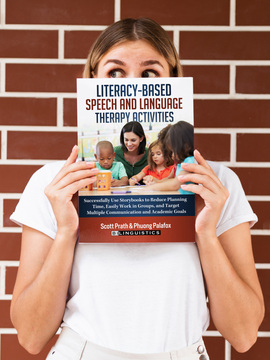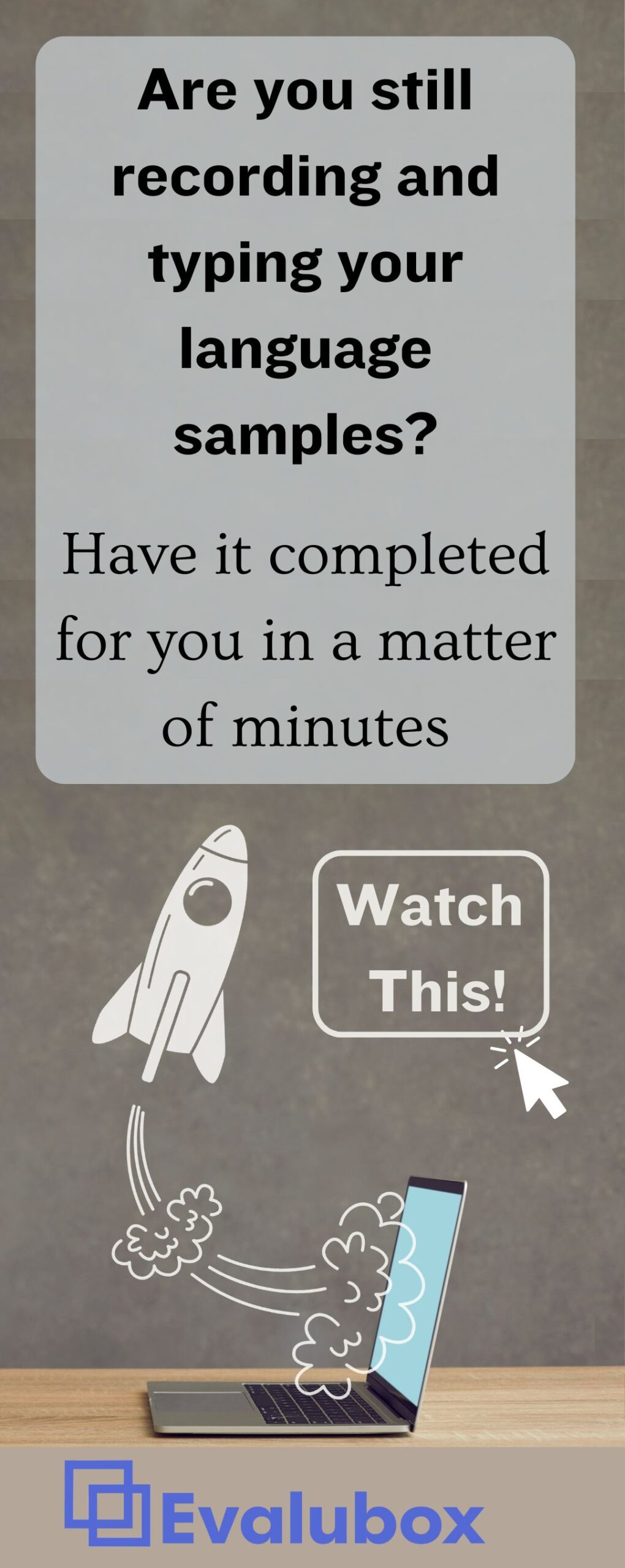Executive functions are a set of mental skills that allow us to have flexible thinking, remember, self-regulate, and demonstrate self-control. Students need these skills to be able to work, learn, work, and participate. We definitely want our students to possess these skills! However, as interesting, intriguing, and helpful as executive function skills are to students, there is one inherent problem for speech-language pathologists trying to serve children with executive function deficits:
Executive function difficulty is not a learning disability. It’s not a disorder we would diagnose and directly treat (yet).
We need to remember that there is no one Executive Function Disorder and debate still exists that it is a diagnosable category at all. What we do know is that Executive Function Skills enable a student to be successful and these skills are often lacking or deficient when certain diagnosable disorders exist.

For example, you may go to the doctor because you have a fever, but the fever is not the illness or disease. It is a negative result of something like a cold, injury, or the flu. We treat the fever as part of the sickness and the fever goes down.
Equally so, decreased executive function skills are often present with and related to Autism, ADHD, Emotional Disorders, and Learning Disabilities. When we treat EF skills alongside the primary diagnosis, the student measurably gets better.
So knowing what we know about children with poor executive function, how do we target strategies and add them to our therapy?
The answer lies in understanding the relationship between executive function and four deficits we already treat:
Autism – Emotional Disorders – ADHD – Learning Disabilities
How Executive Function and Autism Overlap
Autism Spectrum Disorders vary widely in their conditions and degree of severity. However they share two core features. Typically a child has impaired socialization and communication abilities. Within each of these categories there are executive function skills that can be targeted to assist in making their interactions more typical.
Children with Autism Spectrum Disorders vary widely in the way they are able to interact with others. On one end of the spectrum a child can appear completely shut down and not engage or reciprocate with others. Others may make eye contact and talk but only when requested.
Mental Flexibility and Self-Regulation
The executive function skills that enable positive relationships include mental flexibility and emotional self-regulation. Children need to be able to adapt to changes in play and emotionally handle new situations or situations where they do not get what they want. Academically, a student who struggles with executive function and autism, can disengage from activities and miss blocks of learning. Executive function strategies can reduce the reaction to difficult situations and extend learning windows.
Executive Function and Autism Goal Targets
Children with autism also have a variety of communication patterns. These differences range from non-verbal communicators to overly verbal communicators who fixate on topics without stopping. These executive function skills can be targeted to improve the communication of children with autism at any level:
- Flexibility – The ability to stop a conversation that may not interest another or the ability to engage in a conversation that does not interest them.
- Initiation – The ability to independently greet a person or engage in conversation
- Emotional self-control – The ability to share their feelings constructively and not inject overpowering emotions into a situation
- Task Completion – The ability to stop a task. This is often difficult for children with autism as their disorder can include repetitive rituals where they continue on with an activity such as coloring and become upset if their routine is broken.
How Executive Function and ADHD Overlap
Attention-deficit/hyperactivity disorder or ADHD is a disorder characterized by impulsivity, inattention, and in some cases, hyperactivity.
Students with ADHD fall into three general categories:
- Symptoms of inattention
- Symptoms of hyperactivity/impulsivity
- A combination of inattention and hyperactivity/impulsivity
A child with ADHD demonstrates at least six symptoms from the combined list below (5 when older than 17). They also demonstrate these symptoms across a long period of time. It is also important to point out that developmentally all children present with most of these symptoms at some age. What is different about ADHD is that they persist at an age when it is no longer appropriate.
Executive Function and ADHD Goals
Executive function strategies can target a child’s ability to self-regulate, initiate, and complete tasks. If we write our communication goals based on skills for executive function and ADHD needs, we address the 1) the deficit, 2) the desired outcome, and 3) communication.
Here is an example: Through parent/teacher report or through diagnosis, a student “often does not seem to listen when spoken to directly.”
We can translate that into receptive language targets: Child will repeat instructions or verbal requests to demonstrate understanding with minimal support.
And here are examples of some examples of diagnostic criteria for ADHD for inattentiveness and hyperactive impulsiveness.
Inattentive Symptoms:
- Often fails to give close attention to details or makes careless mistakes
- Often has difficulty sustaining attention in tasks or play activities
- Often does not seem to listen when spoken to directly
- Often does not follow through on instructions and fails to finish schoolwork
- Often has difficulty organizing tasks and activities
- Often avoids or is reluctant to engage in tasks that require sustained mental effort
Hyperactive Impulsive Symptoms:
- Often fidgets with or taps hands or squirms in seat.
- Often leaves seat in situations when remaining seated is expected.
- Often runs about or climbs in situations where it is inappropriate.
- Often unable to play or engage in leisure activities quietly.
- Often talks excessively.
How Executive Function and Emotional Disorder Overlap
Emotional disorders and executive function deficits overlap because a child who suffers from anxiety or depression can have difficulty initiating tasks, be unmotivated, and may not have the energy to continue working on a task. Executive function strategies can be used to modify curriculum in order to allow the child to continue to learn in an environment where they feel safe.
A child who suffers from anxiety or depression:
- May have difficulty initiating tasks
- May be unmotivated
- May not have the energy to continue working on a task
Imagine a child who has suffered a loss. Will they be able to keep their mind on a passage long enough to comprehend it? And what about test-anxiety? We all suffer from it to some degree but imagine a level of anxiety that is so crippling that no test can be completed? Or worse yet, an impending test that causes loss of all appetite and sleep.
We can use executive function and emotional disorder strategies to modify the way the curriculum is delivered so that we can still do our job. We can cause learning to happen and create an environment where the child feels safe.
How Executive Function and Learning Disabilities Overlap
Learning disabilities are the most common diagnosis that we come across in the schools. To say that a child has a learning disability, we have established that they have normal intelligence, that they have strengths in certain academic areas, and that they are below average in others.
For example, a child could have visual and verbal memory that are typical or above average but be below average in phonological processing skills and eye-hand coordination. Typically these students have interventions just for their specific difficulties.
A learning disability is a neurological disorder.
Children with learning disabilities have typical intelligence but may have difficulty in spelling, reasoning, writing, reading, recalling and/or organizing information.
Children with learning disabilities fatigue more easily, work more slowly, and require more time to complete tasks.
Executive function strategies give us the necessary tools to:
- Keep a student engaged
- Identify motivations
- Continually progress
Think about a time when you struggled with something. It is rare for us as adults to experience novel learning situations but for our students everything is new. Typically, new tasks are acquired well and certain subjects require a little more effort on our part. But imagine breaking your dominant hand. How frustrating will it be to write, type, and brush your teeth with your non-dominant hand? Yes, you will accomplish your tasks but only through heightened effort and grit. This is the experience of children with learning disabilities in their deficient subjects.
Children with learning disabilities fatigue more easily, work more slowly, and require more time to complete tasks. Using the example from above, because the child struggles with verbal memory abilities he will have to work extremely hard repeating questions and verbalizing answers to questions you ask. He will work slower than his classmates and probably feel inadequate or embarrassed by his performance in this area. For obvious reasons this may affect his motivation to participate the next time it is his turn.
Executive function strategies supply the scaffolding needed for the child to work at his level. With his diagnosis his work will already be modified to account for his disorder but executive function strategies give us the necessary tools to keep him engaged, identify his motivations, and continually progress.
Executive Function Information that Directly Relates to Speech Pathology and Helps Us Do Our Jobs
There is information out there about Executive Functions thanks to many great minds at work. But, how much of it is directly related to communication and speech therapy? We thought there wasn’t enough. That’s why we consolidated the information, resources, and research into these three Executive Function CEU Courses:

Access and develop a student’s cognitive abilities to improve their attention, behavior, and organization.
We began by identifying why students with executive functioning disorders struggle with attention, organization, and behavior. Then, we relate these difficulties to classroom performance and home behaviors.

Use research on Executive Function to increase student motivation and their ability to stick with tasks.
Strategies for executive function can be incredibly successful but there are a number of students who still have no success despite multiple interventions. This course presented strategies and interventions for when students are not motivated to perform a task and don’t understand why they should learning something new.

Understand the development of executive function and become familiar with the cognitive processes that produce executive function skills.
We dive into environmental and developmental factors that inhibit the natural development of executive function and describe how executive skills progressively improve throughout life.
5 Part Executive Function Series
Part 1: Executive Function in Speech Therapy – What is Our Role as SLPs?
Part 2: Building Student Executive Functioning Skills
Part 3: 9 Ways Executive Function Affects Learning
Part 4: Executive Functions of the Brain – Understand This and Understand Your Students
And a Bonus!: Helping When Children with Executive Function Difficulties Have Additional Diagnoses





The section titled “How Executive Function and Emotional Disorder Overlap” seems to have an error in the Socialization section. That paragraph seems to be nearly identical to the one above it.
You are right. That paragraph was repeated for some reason. I deleted it. Thanks for the note.
Scott
Why is second-language learning included as a diagnosis in your list in the email I just received, when it is a normal developmental process? This contributes to the myth that bilingual learners come with some sort of deficit!! We know better colleagues.
Hi Theresa,
First off, you are absolutely right. We don’t want to confuse typical development during second language development with disorder. This essay talks about 4 additional diagnoses: Autism – Emotional Disorders – ADHD – Learning Disabilities, not bilingualism. Are you referring to the piece on bilingualism in the course Executive Function 301? We talk about why and how to NOT to misdiagnose difficulties with EF with bilingual development. If I am overlooking something in this article on bilingualism, let me know. That might need it’s own explanation through a separate blog article. Thanks for the comment.